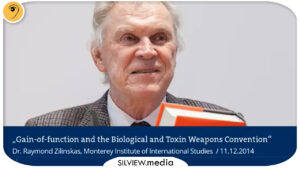Early gain-of-function and bioweapons research in USSR AND Russia – Rare insider report
Sat 1:22 pm +01:00, 30 Oct 2021
I dug out for you a big gold nugget from a Johns Hopkins specialist who also inspected Iraq on behalf of UN searching for bioweapons. If you pay close attention, this talk delivers powerful details on GoF beyond the scope of Russia.
Raymond Zilinskas, Monterey Institute of International Studies Speech at the Herrenhausen Symposium “Dual Use Research on Microbes: Biosafety, Biosecurity, Responsibility”, 11.12.2014
A few key-points:
- You can’t differentiate between bioweapons and vaccine research except by intention, which you can’t really know
- Bioweapons often target crops and livestock. As in ‘swine-flu’.
- They experimented with Nipah and Marburg
- Military oversight as per the Western Military BioTech Complex.
- They are irresponsibly power-tripping
Raymond A. Zilinskas speaks about the first (1928-1971) and second (called FERMENT, 1972-1992) generation biological warfare programs, relevant elements of the Biological and Toxin Weapons Convention, and Russian weapons based on “genetics”. He provides statistics about the USSR Ministry of Defense biological warfare facilities, the biopreparat biological warfare facilities, and anti-plague institutes. The scientist names examples of FERMENT program’s projects and discusses the program’s legacy in today’s Russia.
The speech has only been recorded in audio:
Zilinskas has worked for the U.S. Office of Technology Assessment, the U.N. Industrial Development Organization, the University of Maryland Biotechnology Institute, the School of Hygiene and Public Health, and the Johns Hopkins University. In 1994, he twice served as UNSCOM biological inspector in Iraq. Currently he directs the Chemical and Biological Weapons Nonproliferation Program at James Martin Center for Nonproliferation Studies, Monterey Institute of International Studies, California.
Early Gain-of-Function and bioweapons research in USSR and Russia – rare insider report










